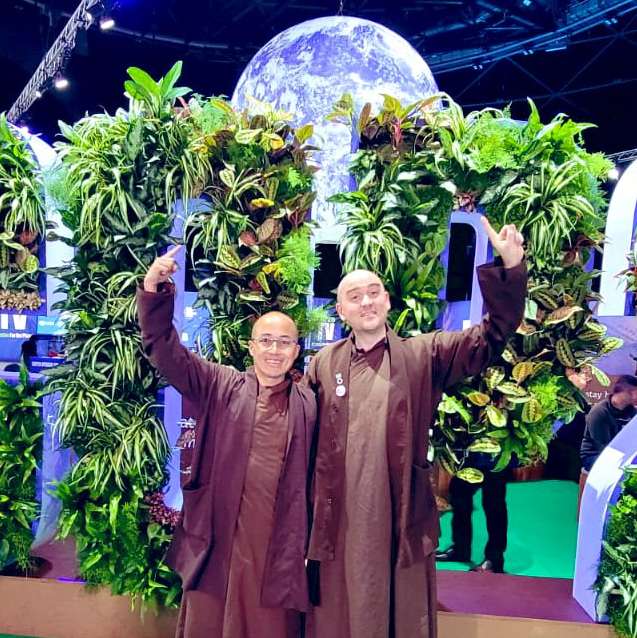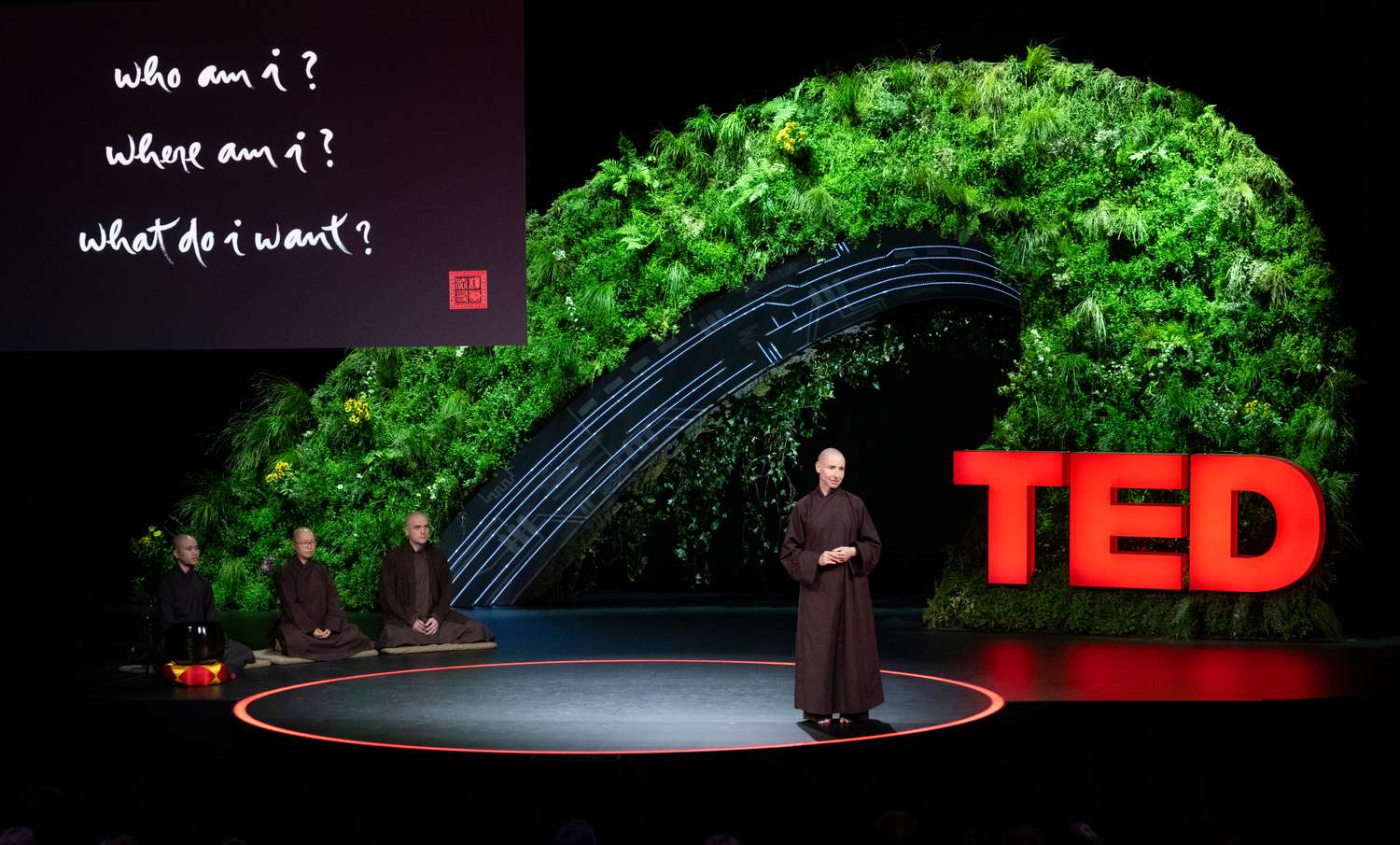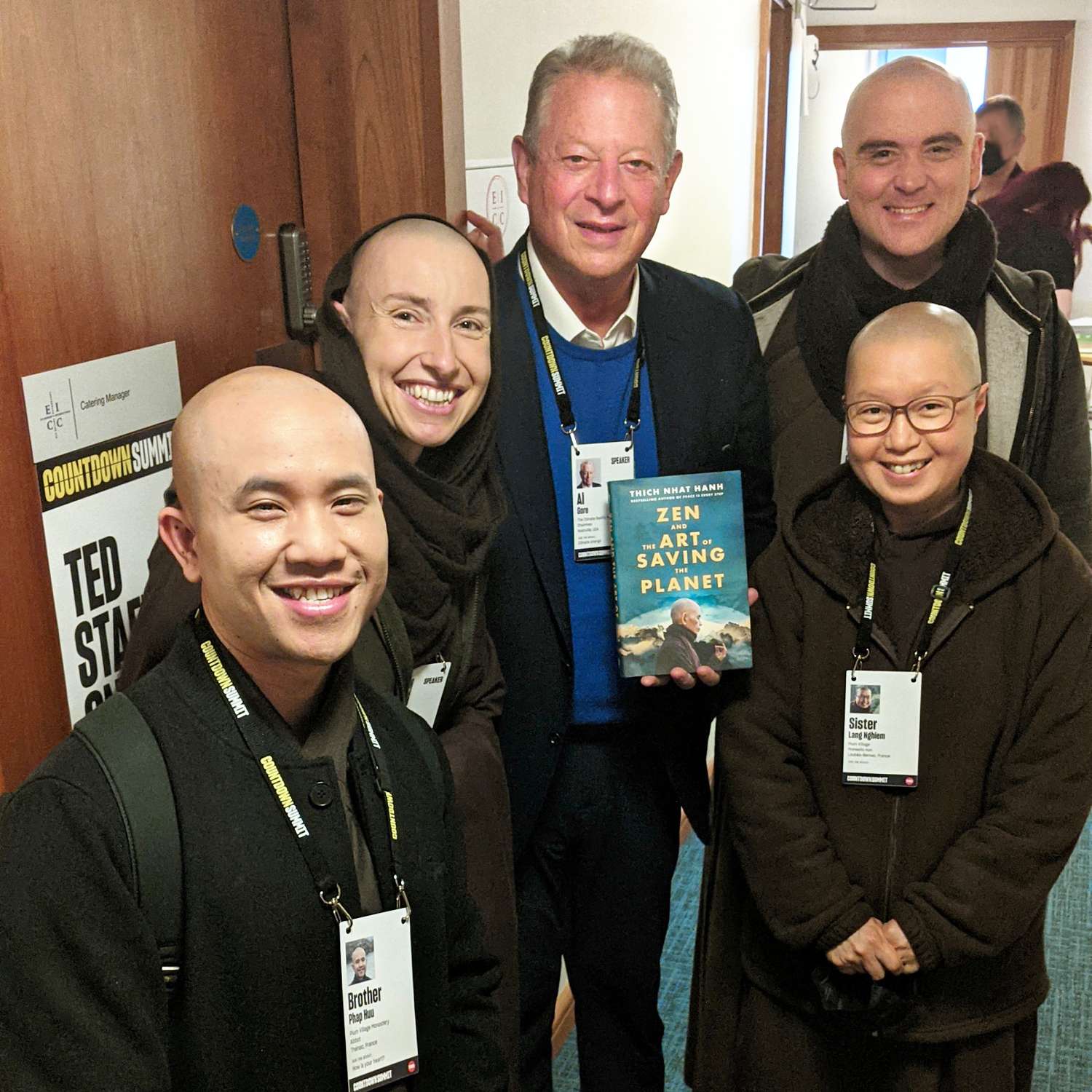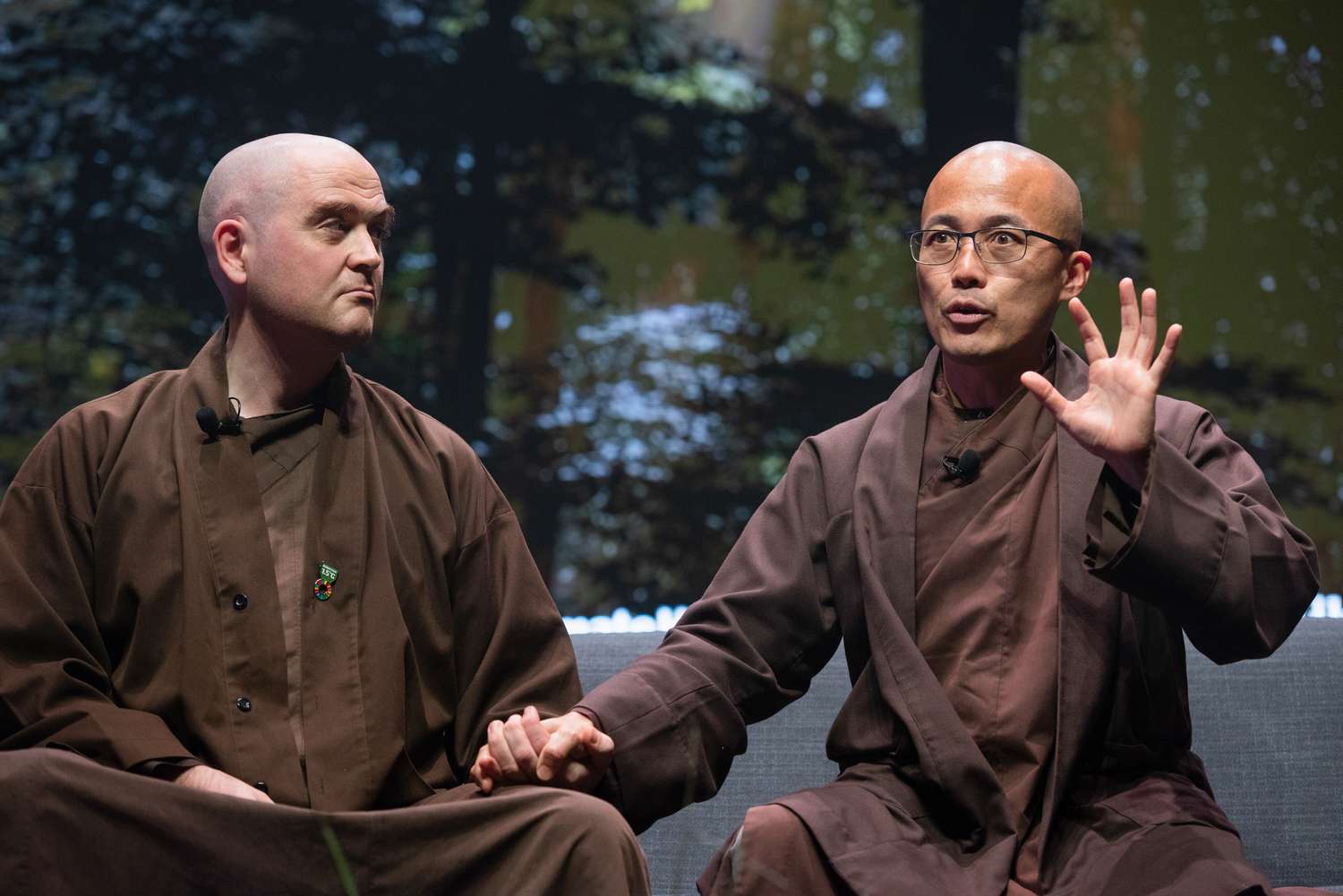
Brother Chân Pháp Linh

Living interbeing, joy, and non-fear at COP26
Do you remember the moment you went from being aware that nature was being damaged and destroyed, to deciding that you would take action to stop the destruction?
One of the most sacred places for me as a child was a certain forest in the hills, near where we lived, in the North of England. In the autumn, we would go there as a family to pick mushrooms, and these are some of my happiest childhood memories. It was a wild and beautiful wood in a deep, twisting valley, carved by a loud, rushing torrent. Some of the best places to find mushrooms were mossy banks so steep you had to hang on to the grass with your hands not to go tumbling down the ravine. We never saw anyone else in that wood–it felt like it was our very own special place. We would come home with baskets overflowing with delicious mushrooms–chanterelles, horns of plenty, hedgehog mushrooms, and of course, the majestic cèpes! I vividly remember the pure and simple joy of discovering hidden patches of mushrooms under the fallen leaves, nestled down deep in the thick moss.
One year we went back there and half the wood was gone. On one side of the valley, every single tree had been chopped down and dragged away. What was left looked like a battlefield. Even the side that had not been cut felt damaged, as if the trees were in mourning. Where the forest had been felled, the earth was torn–scarred with the tracks of giant machines. The whole forest felt diminished, broken and vulnerable. I felt so angry and confused. Why would anyone do this? Why would anyone destroy this magical cathedral of green and leave behind a wasteland?
Looking back, I think this was one of those pivotal moments when I went from being aware that nature was being damaged and destroyed, to making the determination to take action and stop the destruction. I was determined to try to find a way for us to live without cutting off the very branch we were sitting on. The first time I heard the term “global warming,” I was around twelve years old, and since then, my whole life has been lived with an awareness of the rapidly accelerating pace of desecration of our earth. For years I struggled to see how I could make a difference in the face of such a gigantic threat, and I was convinced that we were in fact doomed as a civilisation. It was only when I met Thay and the sangha that I started to see a path forward.
We know that our climate is now rapidly changing and we may already have irreversibly disrupted the delicate balance of conditions that allowed us to flourish as a species over the last 12,000 years. We are already seeing the effects of climate stress in many parts of the world, which make life more difficult, especially for those on the edge of poverty. This is happening now.
This is in large part why I became a monk. I could see that for humanity, the years of being able to take and take from Mother Earth would soon be coming to an end. The only question for me was how to act now, knowing what was to come.
As I spent more time with the monks and nuns in Plum Village, and listening to Thay’s teaching, I started to imagine what the world would be like if there were more people in it who were trained like them; people trained in the art of peace–who would not take sides in a conflict, who would share their last morsel of food, who would bring the balm of love and forgiveness to a situation of anger and fear, and who would know how to help people heal from the scars of trauma in its many forms. Perhaps more than all of that, I started to see the power of a group of people trained in the art of living as a community.
Thay has always been very clear that it is the applied insight of interbeing, that can help our civilisation to change from its current course of destruction. We know that it is the prajnaparamita insight of emptiness that can cut through the bonds of our suffering–the suffering that binds us to a way of life driven by competition and selfishness. But sometimes that insight seems far away, abstract or impractical–I used to think of it as something that could only be realised after many decades of practice, or even something that I could not attain in this life. But now, and especially after going to Glasgow, I see that we are already living this insight, which is built into the very fabric of our life as a community. It is this applied insight that we can offer to the world.
TED Countdown
In October, Brother Phap Huu, Sister Lang Nghiem, Sister Hien Nghiem, and I attended the TED Countdown event in Edinburgh. It was an event designed to inspire and prepare people for the COP26, UN Climate Summit in Glasgow, which would take place a couple of weeks later. When we returned to Plum Village, we were all focussed on rejoining the annual Rains’ Retreat. But so many people had been touched by the presence of the monastics in Edinburgh, especially by Sr. Hien Nghiem’s TED talk, that they then wanted to invite us to Glasgow as well. We quickly re-assessed the situation and found a way for two of us to represent the sangha at this historic event.

Suddenly I was faced with the prospect of going to COP26, and to be honest it was quite scary. What would we say? What did we really have to offer? Would we really be able to help? I had no idea. We didn’t even really know what we would be doing there. But at the same time, I was on fire with the aspiration that had been in my heart since I was a little boy–I had been searching my whole life for a way to help avert the present and future crises that we face, and now we had an opportunity to contribute.
My grandfather’s lawn
Another memory—every summer when I went to visit my grandparents in France, one of my favourite things to do was to lie down in the long grass, completely motionless, and just look. I would disappear into the weird and wonderful world of the colourful, shiny, metallic bugs, and big scary spiders with their bright yellow stripes; the drab grey grasshoppers, whose iridescent blue and red wings would only become visible when they were startled into jumping and fluttering to a new perch. But every time my grandfather mowed the grass, this rich and diverse world was destroyed. I never stopped trying to persuade him to let nature take its course and allow the field to grow and grow, undisturbed—to become a wild place again, full of life and wonder.
COP26–Invoking the sangha
Just a few short days later I found myself in Glasgow, reunited with my mentor, teacher, elder brother and true friend on the path, Br. Phap Dung. It was such a joy to reconnect and share our excitement about what flavour of Dharma we wanted to offer–we stayed up late, sharing back and forth, and laughing a lot. In Edinburgh I had noticed that what touched people the most was seeing the way we operated as an organism–as one body. And as we talked, it became more and more clear that this was what we had confidence in: our practice of sangha interbeing-ness, our brotherhood and sisterhood. The world is being destroyed by individualism, competition and greed, and the medicine is the living insight of interbeing. So we made the determination to do our best to embody this insight, and to constantly take refuge in the felt, embodied sense of connection with our brothers and sisters, our teacher, our ancestors and the earth. We were determined not to be there as separate selves, but as two leaves at the tip of the branch, knowing that in truth we were much more than what can be seen with the eyes. We were not just two brothers, we were the whole tree, the roots, and the mycelial network which connects the whole forest. Any time I did not know what to say or do, I would do my best to light up this awareness, connecting myself with the Sangha–with the brothers and sisters, with Thay, with spiritual ancestors, and with Mother Earth herself–then everything became easier.
Sharing with the delegates at the conference, we were so happy to discover that the insight of interbeing and interdependence is also growing stronger in the world. Actually, in the environmental movement, almost everyone knows that this is the way forward, but what I started to see was that for many, this insight remains at the intellectual level and does not translate into their way of life. They understand the principle of interbeing, but they are still living as a separate self, as an individual who has to make a living, make a reputation for themselves–a career and an identity. But the good news is that when they see a practical example of how the insight can be applied, they get it right away. You just have to scratch the surface, and they are ready to transform. That’s the good news!

Practising applied interbeing
My greatest joy during those days in Glasgow was to see that Thay has given us everything we need to help these people take the next step. In the sangha, we are trained to live together and to rely on each other, and interbeing is alive at every level of our teaching and practice. All we need to do to transmit the insight of interbeing is to be ourselves! One thing people noticed was that they could not figure out who was the boss. They knew that Br. Phap Dung is the elder brother, so at first, they thought I was there to work out the logistics and he would do all the talking. But we did not operate like that. Every evening we would be cooking our Dharma, discussing what we felt had worked, reflecting on what we could still fine-tune, and just sharing our insights. The next day, it did not matter which mouth the insight came out of–there wasn’t the feeling of “Hey, you used my line–that was my insight,” it was truly like we were one body with two mouths. We were operating as one and everyone could feel that. We were not doing anything special; it is just how we are trained in Plum Village, and what a contrast that makes with how most of the world operates. It really wakes people up. They start to see how interbeing is not just a concept but something that we can live.
One morning when I woke up, I could not stop smiling. I was lit up with gratitude to Thay–I felt so grateful that we have something to offer and it works! Thay has prepared everything so perfectly. He has offered us ways to teach and to practice which help right away. That is truly the greatest happiness. I later shared this simple insight with Br. Phap Dung, and in the sharing, the joy grew and grew, reflected back and forth between us.
That simple joy was also part of what we were offering. So many people are overwhelmed with despair and anxiety, especially in the environmental movement. They know more than most of us how bad things really are and the more they know, the worse it seems. At COP26, there was a very strong collective feeling of “Time is running out,” and “It’s probably too late already.” Again and again, we would meet people, and within a few seconds they would break down in tears–not because they were sad, but because they could see and feel our joy, and the presence and joy of the Sangha through us. They could see that we were actually living the solution they sought and that immediately gave them hope. Our joy became their joy and they were able to continue their work in a new way. They were crying tears of relief, because now they could see that living in the insight of interbeing is something possible, not just a dream for the future.
They were touched also by our (relative) non-fear of their suffering. We are all trained to listen to the suffering of others, so when people would share their suffering with us, we (mostly!) didn’t feel overwhelmed by it, and we knew (at least a little bit) how to help them to embrace it. And this is something that can only come from having faced some of our own suffering.
Every tiny step of transformation we have made on the path is directly connected with what we can offer to others. Every time we’ve been able to embrace some of our own sadness and confusion, every time we’ve been able to take a breath or two and soften a feeling of pain instead of reacting, every time we’ve been able to breathe through our anxiety or victimhood and liberate ourselves from it, even just a tiny bit–manifests as non-fear and confidence when we are with someone who is suffering. We know that it is possible to transform our own pain, that is why we know that it is also possible for someone else. The other person can feel that, and when they feel that non-fear from us, they already get some relief.

The value of transformation
Our own transformation is the offering and as a sangha we have a lot to offer because all of us are walking that path, and all of us have been able to transform something, even if sometimes it feels like it’s not enough, and even though we still suffer now and then. Collectively, we transmit the lived experience of the transformation of suffering–the knowledge that it is possible–and that, more than anything else, is what the world needs right now.
In Glasgow, both Br. Phap Dung and I felt so lucky that we get to do this work in this life—that we get to make a difference, just by living as a cell of the Sangha body. It is truly a great fortune, given the awareness of suffering in the world, and the awareness that the suffering may increase greatly in the coming years, to realise that we can do something, and that as a sangha, we can do a lot.